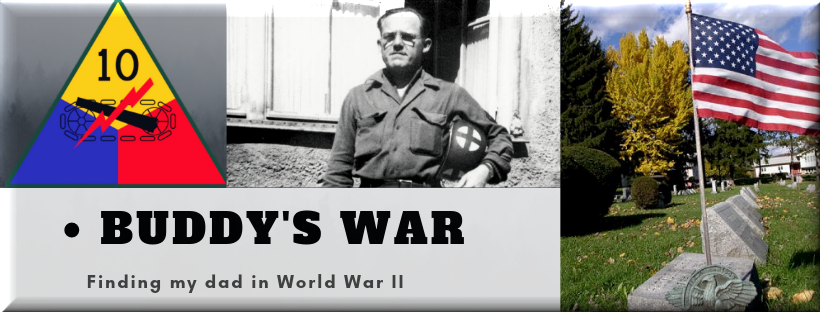1st Letter from Buddy. He arrived in France all OK. Said he had a nice trip going over. Dora called and said she received a letter alsoIn general, as applied to infantry units,
— Diary entry, Beula Keller Lehman
The Medical Battalion was a Divisional medical unit developed to furnish medical support for the Infantry Division. Its primary mission was to organize and conduct the necessary evacuation and medical care for casualties of the Division. Because of the high mobility of the Division, the installations of the Medical Battalion had to be of a more temporary nature and possess increased readiness and ability to maintain contact with the different units of the Division. The Medical Battalion was thus charged with the evacuation of ALL casualties from the Infantry Battalion and Regimental Aid Stations. If for any reason, casualties could not be gathered at the Aid Stations, the Collecting Companies would remove casualties directly from the field.
The Medical Battalion was organized as a kind of ‘miniature’ medical organization in order to maintain the best operative coordination of all the existing facilities and to give flexibility to a possible expansion of the medical service when necessary. It always accompanied the Division in the field! (Link)Armored medical battalions were training slightly differently in light of armored movements being different from infantry. They also looked at other special issues, such as extricating the wounded from tanks! There was a unique field manual for the armored medical battalions. The schematic shows the idealized view of how they were to be set up.
(P. 2; Armored Med Units Field Manual 1944)
Like the infantry battalions, the armored battalions needed to be ready to move at quick notice. The Armored Medical Units Field Manual, 1944 has specifics about how and what to do in advancing or “retrograde” movements. It also gives these details about the general organization of the companies of the medical battalions:
The armored medical battalion is a flexible, highly mobile unit capable of accompanying combat elements of the armored division. It is composed of a headquarters and headquarters company and three identical medical companies.Undoubtedly they had received a great deal of training on this in the States prior to leaving. Here they bivouacked and most likely learned the ins and outs. It had to become second nature, I am sure, to be able to do what was needed in difficult and dangerous circumstances. This was all preparation time. After they had set up the bivouac in the rain on 23 September, the morning reports through 25 October simply say:
21. FUNDAMENTALS OF EMPLOYMENT, a. The medical battalion provides second echelon medical service by the collection, treatment, clearing, and evacuation of the sick and wounded of the division. It is self-contained administratively and technically, having its own maintenance, administrative, and supply organization.
b. Flexibility of the medical battalion is always maintained. The battalion is organized to be responsive to any demand made upon it for reinforcement or support. It can function as a unit, or its several major components may be broken down into lesser elements to support tactical groupings. In combat, usually one medical company supports each combat command. (p. 25)
✓ 24 September 1944- 25 October
✓ Company C Morning Report
Field duties at bivouac site. (MR)
Meanwhile, since the 10th/80th had arrived in the European theater:
◆ 75 Years Ago
◆ 25 September 1944
Operation Market Garden ended. It had begun on 17 September when Allied paratroopers landed in the Netherlands and Germany. They did not cross the Rhine and ended with an Allied defeat.
◆ 27 September 1944
The Battle of Metz began. It would stall and then not be finished until Patton, the Third Army, and the 10th Armored joined later in the fall.
A piece of family “lore” comes to mind as I work on these early days in Europe. My aunt, Buddy’s sister, Ruth, told me a number of times that the family believed that when he went overseas he was actually too old for the deployment into battle. In October 1944 he was actually about a month shy of 39 years old. It is important to also remember that Buddy had lied about his age when he first enlisted in 1940, saying he was a year younger than he was. As far as the army was concerned, as he bivouacked in France he was not even 38 yet. I was told that Dora and the family tried in vain through letter writing to get him discharged prior to his deployment. They were told by one of his superiors, however, that he wasn’t going to let a medic as good as Buddy be discharged.
Whether he was too old, should have been there or not, Europe was where he was- a medical corpsman with Patton’s Third Army and the 10th Armored Division about to be part of the last seven months of the war in Europe. In pictures that I have of that era, he almost stands out like someone who shouldn’t be there. He is clearly older than most of the guys around him. He is an elder among his band of brothers.


No comments:
Post a Comment